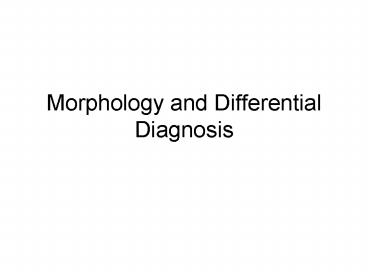Morphology and Differential Diagnosis - PowerPoint PPT Presentation
1 / 92
Title: Morphology and Differential Diagnosis
1
Morphology and Differential Diagnosis
2
Welcome to Dermatology!
- No matter what area of medicine or surgery you
pursue, you will get skin related questions from
family, friends, and patients. - The time frame is short, so make the best use of
your time. Carry your book with you at all times
and try to make it through all the photos.
3
Suggestions for a Successful Rotation
- Be on Time!
- Be attentive and helpful.
- Do not ask questions or make comments during the
patient encounter. Please ask all questions
outside the exam room. - Please do not talk loudly in the hallway.
4
Macule
5
Macule
6
Macule
7
Patch
8
Papule
9
Papules
10
Papules
11
Papules
12
Plaque
13
Plaque
14
Plaque
15
Nodule
16
Nodule
17
Nodule
18
Tumor
19
Tumor
20
Tumor
21
Pustule
22
Pustule
23
Vesicle
24
Vesicle
25
Vesicle
26
Bulla
27
Bulla
28
(No Transcript)
29
(No Transcript)
30
(No Transcript)
31
Wheals
32
Wheals
33
Special Skin Lesions
- Burrow Thin linear papule or plaque
- Comedone Follicular papule filled with
keratinous plug which is open or closed - Cyst Papule or nodule filled with debris
- Telangiectasia Dilated blood vessel less than 1
mm wide
34
Burrow
35
Comedone
36
Telangiectasia
37
Cyst
38
Secondary Lesions
- Scale
- Crust
- Erosions and ulcers
- Excoriations
- Fissures
- Scars
- Lichenification
- Atrophy
39
Scales
40
Scales
41
Scales
42
Crust
43
Crust
44
Excoriations
45
Erosion
46
Erosion
47
Ulcer
48
Ulcer
49
Ulcer
50
Fissure
51
(No Transcript)
52
Fissure
53
Atrophy
54
Atrophy
55
Atrophy
56
Atrophy
57
Scar
58
(No Transcript)
59
(No Transcript)
60
Lichenification
61
Configuration
- Annular
- Arcuate
- Geographic
- Discrete
- Confluent
- Serpiginous
- Linear
- Reticulated
62
Annular and arcuate
63
Linear
64
Erythema Subitum
65
Descriptors
- Punctate
- Lichenoid
- Umbilicated
- Scarletiniform, morbiliform
- Leonine
66
(No Transcript)
67
Color
- Pink
- Violet
- Orange
- Blue
- Green
- Yellow
- Black
- Brown
68
Color
- PinkPityriasis rosea
- VioletLichen planus
- OrangeJuvenile xanthogranuloma
- BlueAmioderone skin pigmentation
- GreenPseudomonas
- YellowXanthomas
- Blackeschar
- BrownCafé au lait spots
69
Color
70
Distribution
71
Morphologic categories
- Macular-Patch
- Papular
- Papulosquamous (scaly papules)
- Nodular
- Pustular
- Vesicular-bullous
- Urticarial
- Petechial
- Telangiectatis
- Burrow
- Poikiloderma
- Hyperkeratotic/scale
- Atrophic
72
More is missed by not looking than by not
knowingM. McKay, M.D.
73
Procedures
- Liquid Nitrogen
- Electrodessication and curettage
- Biopsy
- Punch
- Shave
- Excision
74
(No Transcript)
75
(No Transcript)
76
(No Transcript)
77
(No Transcript)
78
Seborrheic Keratosis
- Common Skin Tumor of unknown cause.
- Predilection for trunk, scalp, temples
- No malignant potential
- Increase incidence with age
- Easily treated with curettage or cryodestruction
79
Dermatosis Papulosa Nigra
- Most likely a subtype of seborrheic keratosis
- Malar areas, most commonly on African-American
women
80
Acrocordons (Skin Tags)
- Common, occurring in about 25 of adults
- More common in obese individuals and often
develop in pregnancy - Frictional areas such as neck, axillae,
inframammary and groin locations - Can become irritated or infarcted because of
torsion
81
Dermatofibroma
- Firm papule often with brown pigmentation, most
frequently seen on the anterior legs - Dimple sign
- May be a reactive process to an insect bite
reaction rather than a tumor - If multiple, sometimes associated with systemic
lupus erythematosis
82
Dermatofibroma
83
Keloids
- Hypertrophic scar which extends beyond the area
of injury - May have delayed onset, even up to years after
injury - Can be painful
- More common in African-Americans
- Treatment can be difficult and choices include
intralesional steroids, radiation, careful
excision, laser ablation
84
(No Transcript)
85
Epidermoid Cyst
86
Trichilemmal (Pilar) Cyst
87
Actinic Keratosis
88
Keratosis Pilaris
- Follicular papules, commonly on extremities
- sandpaper feel
- 20 of the population affected
- Worsens in adolescence
- Common in Atopics and icthyosis
- May improve with keratolytics, retinoids,
dermabrasion
89
Keratosis Pilaris
90
Keratosis Pilaris
91
Cherry Angiomas
- Benign vascular proliferation
- senile hemangioma dont use this term with
patients ? - Usually appear on trunk, start at age 30,
increase with age - Dilated capillaries
- Tx for cosmetic reasons only
92
(No Transcript)































